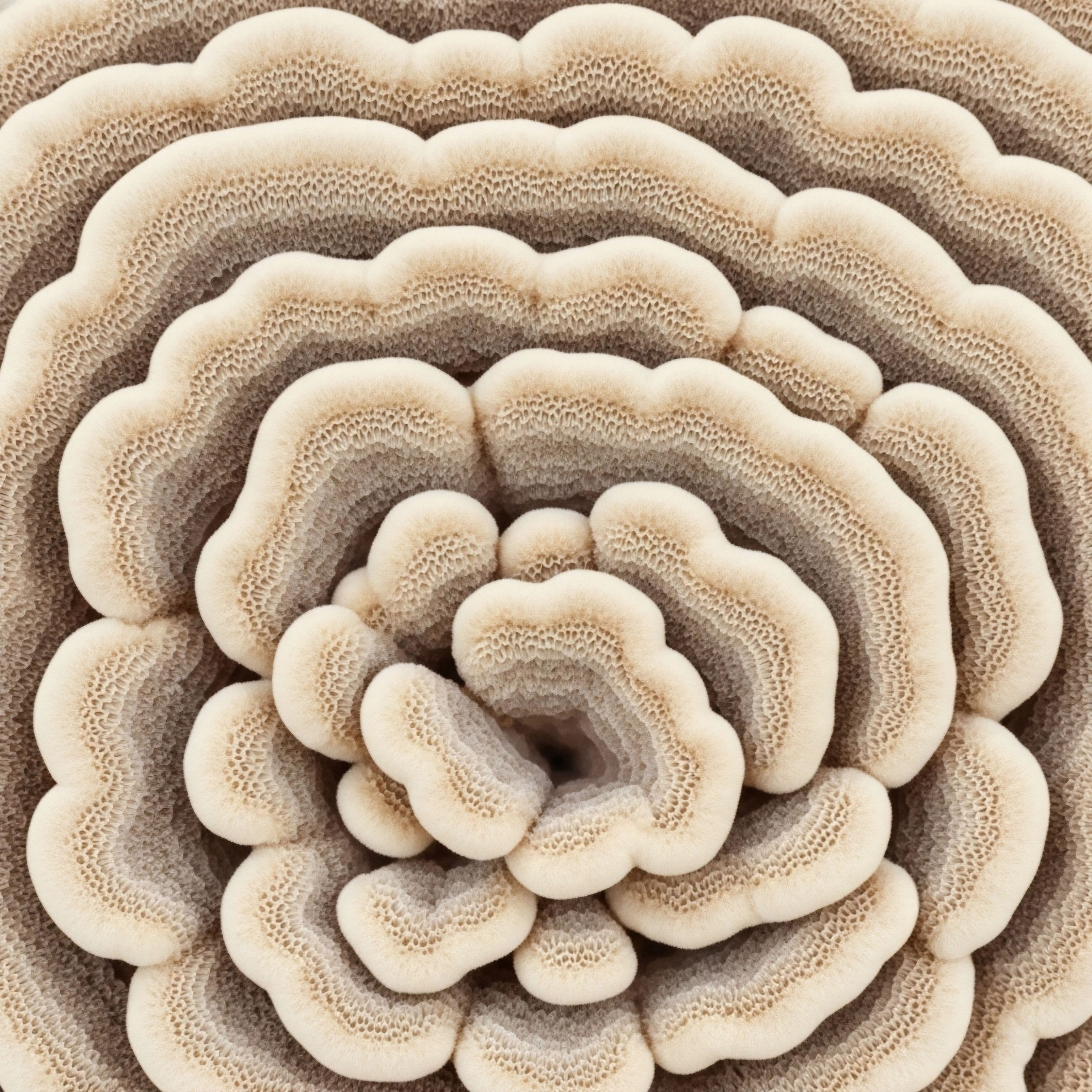

Fundamentals
The experience of seeing more hair in the brush or noticing a subtle change in the density at your temples is a deeply personal one. It often begins as a quiet observation, a private concern that grows over time.
This process, which can feel unsettling, is the direct result of a highly specific series of biochemical events occurring within your own scalp. Understanding this journey begins with appreciating a central concept in human physiology ∞ hormones, our body’s powerful chemical messengers, can produce distinctly different effects in different tissues.
The same hormonal signals that drive vitality and strength in one area of the body can initiate a process of gradual decline in another. This is the biological reality at the heart of androgen-driven hair thinning.
Your body produces and utilizes a family of hormones called androgens. The most well-known of these is testosterone. In many tissues, testosterone promotes growth and reinforcement. Within the scalp of genetically susceptible individuals, however, a different story unfolds. Here, testosterone interacts with an enzyme named 5-alpha reductase.
This enzyme acts as a catalyst, converting testosterone into a much more potent androgen called dihydrotestosterone, or DHT. It is this conversion that stands as the initiating step in the miniaturization of hair follicles. The presence of testosterone itself is the baseline condition; its transformation into DHT is the specific action that triggers hair loss.
The conversion of testosterone to the more powerful dihydrotestosterone (DHT) within the scalp is the primary trigger for hair follicle miniaturization.

The Lock and Key Mechanism
To understand how DHT exerts its influence, we can use the analogy of a lock and key. Your hair follicle cells are covered in docking sites called androgen receptors. These receptors are the locks. DHT is a key that fits these locks with remarkable precision and affinity, far more effectively than testosterone itself.
When DHT binds to these receptors, it unlocks a cascade of genetic instructions within the follicle’s cells. This signal is the command that fundamentally alters the hair’s life cycle. This process is not a matter of having “too much” testosterone systemically, but rather a localized phenomenon of heightened DHT concentration and receptor sensitivity in the scalp.
This binding event directly impacts the hair growth cycle, which is composed of distinct phases. The most important phase in this context is the anagen, or growth, phase. The genetic signals initiated by the DHT-receptor connection instruct the hair follicle to shorten its anagen phase.
Each subsequent hair cycle, therefore, has a progressively shorter growth period. The result is a gradual transformation. The thick, pigmented, and robust terminal hairs that constitute a full head of hair are slowly replaced by finer, shorter, and less pigmented vellus hairs, a process known as follicular miniaturization. Eventually, these follicles may become so small that they no longer penetrate the surface of the skin, leading to the visible appearance of thinning hair.


Intermediate
To move from a foundational knowledge to a clinical understanding of androgenetic alopecia, we must examine the specific biological machinery involved. The process is not a simple hormonal event but a complex interplay of enzymes, genetic predispositions, and cellular signaling. The central enzyme, 5-alpha reductase, is the gatekeeper that determines the local concentration of dihydrotestosterone (DHT) in the scalp.
A person’s genetic inheritance, in turn, dictates how intensely their hair follicles will react to the DHT that is produced. This combination of enzymatic activity and genetic sensitivity explains why hair loss patterns are so variable among individuals.

The Role of 5-Alpha Reductase Isoforms
The 5-alpha reductase enzyme exists in two primary forms, or isoforms, each with a distinct distribution and role in the body. Understanding their differences is key to understanding both the problem and the solutions.
- Type 1 5-alpha reductase is found predominantly in the skin’s sebaceous glands, keratinocytes, and sweat glands. Its role in androgenetic alopecia is considered secondary, though it does contribute to the overall androgenic environment of the skin.
- Type 2 5-alpha reductase is the primary actor in this process. It is highly concentrated in the outer root sheath of the hair follicles, as well as in the prostate and other reproductive tissues. Its efficiency in converting testosterone to DHT within the follicle itself makes it the principal therapeutic target for treating androgen-driven hair loss.
The activity level of this Type 2 enzyme can be significantly higher in the scalp follicles of individuals experiencing hair loss. This localized enzymatic upregulation creates a potent micro-environment of high DHT concentration, directly initiating and accelerating follicular miniaturization even when systemic testosterone levels are normal.

What Is the Influence of the Androgen Receptor Gene?
The amount of DHT present is only one part of the equation. The other critical component is the sensitivity of the hair follicles to that DHT. This sensitivity is genetically determined, primarily by variations in the androgen receptor (AR) gene.
The AR gene, located on the X chromosome, provides the blueprint for building the receptor proteins that DHT binds to. This location on the X chromosome explains why the trait for baldness is often passed down from the maternal side, though the inheritance pattern is polygenic, meaning multiple genes from both parents contribute.
Genetic variations can lead to an increased number of androgen receptors on each follicle cell or receptors that bind to DHT more strongly, amplifying the miniaturization signal. This genetic component is why some individuals can have relatively high levels of DHT with no hair loss, while others experience significant thinning with only moderate levels.
Genetic sensitivity of the androgen receptors on hair follicles determines the intensity of the response to DHT, making it a critical factor alongside the hormone’s presence.
This leads to a clear, multi-step progression from a systemic hormone to a localized cosmetic change. The process is precise and sequential, offering specific points for clinical intervention.
- Systemic Hormone ∞ Testosterone circulates throughout the body, serving numerous vital functions.
- Enzymatic Conversion ∞ In scalp follicles, Type 2 5-alpha reductase converts testosterone into the more potent DHT.
- Receptor Binding ∞ DHT binds with high affinity to genetically-primed androgen receptors on the follicle cells.
- Genetic Signaling ∞ This binding triggers the expression of specific genes that govern the hair growth cycle.
- Anagen Phase Shortening ∞ The primary outcome of this signaling is the progressive shortening of the anagen (growth) phase.
- Follicular Miniaturization ∞ With each cycle, the hair produced becomes smaller, finer, and weaker, resulting in visible thinning.
Therapeutic strategies like Testosterone Replacement Therapy (TRT) in men and women require a careful understanding of this pathway. While the goal of TRT is to restore systemic testosterone to healthy levels, clinicians must also monitor and manage the potential for this testosterone to be converted into DHT in susceptible tissues.
For men on TRT protocols, this may involve the strategic use of a 5-alpha reductase inhibitor if hair loss is a concern. For women, where lower doses of testosterone are used for balance and well-being, understanding this conversion pathway remains a key part of a comprehensive and personalized treatment plan.


Academic
A sophisticated analysis of androgenetic alopecia (AGA) requires moving beyond the linear model of T → DHT → hair loss and adopting a systems-biology perspective. From this viewpoint, the balding scalp in genetically susceptible individuals functions as a distinct, semi-autonomous endocrine environment.
The pathophysiology arises from a localized dysregulation of androgen metabolism and signaling, which is then amplified by inflammatory cascades and shifts in local growth factors. Systemic hormonal profiles are often poor predictors of AGA onset or severity because the determinative action occurs at the tissue level. The core of the issue is a localized gain-of-function in androgen signaling within the dermal papilla, the cluster of specialized cells at the base of the hair follicle that regulates its growth.

The Scalp as a Localized Metabolic System
The concept of intracrinology, where tissues synthesize active steroid hormones from circulating precursors, is central to understanding AGA. The scalp is not merely a passive target of systemic androgens; it is an active metabolic site. Research has demonstrated that scalp tissue from balding regions exhibits significantly higher levels of 5-alpha reductase activity and DHT concentrations compared to non-balding regions of the same individual.
This indicates a localized upregulation of the enzymatic machinery responsible for creating the potent androgen. Concurrently, these same balding regions show an increased expression of the androgen receptor (AR) gene. This dual amplification ∞ more enzyme creating more DHT, and more receptors to receive its signal ∞ creates a powerful feed-forward loop that drives the miniaturization process independent of circulating testosterone levels.
When DHT binds to the AR in the nucleus of a dermal papilla cell, the activated receptor complex functions as a transcription factor. It binds to specific DNA sequences known as androgen response elements (AREs) in the promoter regions of target genes. This action modulates the transcription of genes that regulate the hair cycle.
Specifically, it is understood to upregulate the expression of genes that secrete antagonistic growth factors, such as TGF-β (Transforming Growth Factor-beta), which promote the transition from the anagen (growth) phase to the catagen (involution) phase. This effectively shortens the growth period, which is the cellular-level definition of miniaturization.

What Is the Role of Inflammation and Prostaglandins?
The androgen-driven process does not occur in a vacuum. Histological studies of balding scalp often reveal a state of low-grade, chronic perifollicular inflammation. This inflammatory infiltrate, composed of activated T-cells and macrophages, may be both a cause and a consequence of the follicular regression. The DHT-mediated signaling itself can promote an inflammatory state. In turn, the inflammatory cells release cytokines that can further impair follicle function.
The interplay between localized DHT overactivity and secondary inflammatory pathways creates a self-perpetuating cycle of follicular distress.
Furthermore, research has identified a critical imbalance in local signaling molecules called prostaglandins within the balding scalp. Prostaglandins are lipid compounds with diverse hormone-like effects.
| Prostaglandin | Function in Hair Follicle | Level in Balding Scalp | Net Effect |
|---|---|---|---|
| Prostaglandin D2 (PGD2) | Inhibits hair growth, promotes catagen phase | Elevated | Suppresses follicular activity |
| Prostaglandin E2 (PGE2) | Promotes hair growth, extends anagen phase | Decreased | Removes a pro-growth signal |
Levels of Prostaglandin D2 (PGD2) are significantly elevated in balding scalp tissue. PGD2 has been shown to inhibit hair growth by binding to a specific receptor, GPR44, on follicle cells, effectively pushing them out of the anagen phase. Conversely, levels of Prostaglandin E2 (PGE2), which is known to promote hair growth, are often found to be suppressed.
This localized prostaglandin imbalance acts in concert with the primary DHT signal to accelerate follicular miniaturization. This finding illuminates why some individuals may not respond fully to 5-alpha reductase inhibitors alone; their condition is being driven by multiple intersecting pathways.

How Do Androgens Affect Follicle Stem Cells?
The long-term progression of AGA involves the gradual depletion of the follicle’s regenerative capacity, which resides in a population of stem cells located in an area of the outer root sheath known as the “bulge.” While these stem cells remain present even in miniaturized follicles, their ability to activate and proliferate to create a new, robust hair shaft appears to be impaired.
The current hypothesis is that the altered signaling environment, rich in DHT and inhibitory growth factors like TGF-β, fails to provide the necessary activation signals to these stem cells. Instead of differentiating into the progenitor cells that build a new hair, they remain quiescent. The table below outlines the key molecular components and their functions in the context of AGA.
| Component | Class | Specific Role in AGA | Therapeutic Implication |
|---|---|---|---|
| Testosterone | Androgen Hormone | Precursor to DHT | Systemic levels are managed in HRT protocols |
| 5-alpha reductase Type 2 | Enzyme | Converts Testosterone to DHT in the follicle | Primary target for inhibitors like Finasteride |
| Dihydrotestosterone (DHT) | Androgen Hormone | Binds to AR with high affinity, initiates signaling | Reducing local concentration is the main goal |
| Androgen Receptor (AR) | Nuclear Receptor | Mediates DHT’s effect on gene expression | Genetic variations determine sensitivity |
| TGF-β | Growth Factor | Promotes catagen entry, shortens anagen | A downstream target of DHT signaling |
| Prostaglandin D2 (PGD2) | Eicosanoid | Inhibits hair growth | Elevated levels contribute to miniaturization |
This multi-faceted understanding, which integrates endocrinology, genetics, and immunology, provides a much more complete picture of androgenetic alopecia. It underscores that effective, personalized therapeutic strategies must account for the interplay between the primary androgenic trigger and the secondary inflammatory and signaling pathways that sustain the condition over time. It also highlights the rationale behind combination therapies that may, for instance, target both 5-alpha reductase and the prostaglandin pathways to achieve a more comprehensive clinical outcome.

References
- Inui, S. and S. Itami. “Androgen actions on the human hair follicle ∞ perspectives.” Experimental dermatology, vol. 22, no. 3, 2013, pp. 168-171.
- Kinter, K. J. and A. R. Anekar. “Androgenetic Alopecia.” StatPearls, StatPearls Publishing, 2024.
- Ustuner, E. T. “Cause of Androgenic Alopecia ∞ Crux of the Matter.” Plastic and Reconstructive Surgery Global Open, vol. 1, no. 7, 2013, p. e64.
- Ho, C. H. et al. “Advances in Transdermal Delivery Systems for Treating Androgenetic Alopecia.” Pharmaceutics, vol. 15, no. 8, 2023, p. 2145.
- Zito, P. M. and B. B. Bohl. “Finasteride.” StatPearls, StatPearls Publishing, 2024.

Reflection

Your Unique Biological Blueprint
The information presented here offers a detailed map of a specific biological process. It traces the path from a circulating hormone to a change you can see with your own eyes. This knowledge serves a distinct purpose ∞ it transforms a source of anxiety into a series of understandable, addressable mechanisms. The science of hormonal health is not about assigning blame or accepting inevitability. It is about understanding the intricate systems that operate within you every moment.
Consider the process of follicular miniaturization as a single, clear signal from your body. What is this signal communicating about your unique genetic sensitivities and your internal metabolic environment? Viewing your body’s responses through this lens is the first step toward a more proactive and informed relationship with your own health.
The journey to reclaiming function and vitality begins with this deep, evidence-based understanding of your personal biological blueprint. This knowledge empowers you to ask more precise questions and seek solutions that are intelligently tailored to your specific needs.

Glossary

5-alpha reductase

hair loss

androgen receptors

hair growth cycle

anagen phase

follicular miniaturization

androgenetic alopecia

androgen receptor

binds with high affinity

testosterone replacement therapy

perifollicular inflammation




